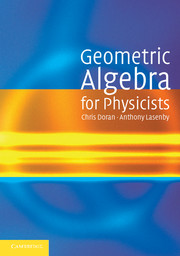Book contents
- Frontmatter
- Contents
- Preface
- Notation
- 1 Introduction
- 2 Geometric algebra in two and three dimensions
- 3 Classical mechanics
- 4 Foundations of geometric algebra
- 5 Relativity and spacetime
- 6 Geometric calculus
- 7 Classical electrodynamics
- 8 Quantum theory and spinors
- 9 Multiparticle states and quantum entanglement
- 10 Geometry
- 11 Further topics in calculus and group theory
- 12 Lagrangian and Hamiltonian techniques
- 13 Symmetry and gauge theory
- 14 Gravitation
- Bibliography
- Index
7 - Classical electrodynamics
Published online by Cambridge University Press: 05 January 2013
- Frontmatter
- Contents
- Preface
- Notation
- 1 Introduction
- 2 Geometric algebra in two and three dimensions
- 3 Classical mechanics
- 4 Foundations of geometric algebra
- 5 Relativity and spacetime
- 6 Geometric calculus
- 7 Classical electrodynamics
- 8 Quantum theory and spinors
- 9 Multiparticle states and quantum entanglement
- 10 Geometry
- 11 Further topics in calculus and group theory
- 12 Lagrangian and Hamiltonian techniques
- 13 Symmetry and gauge theory
- 14 Gravitation
- Bibliography
- Index
Summary
Geometric algebra offers a number of new techniques for studying problems in electromagnetism and electrodynamics. These are described in this chapter. We will not attempt a thorough development of electrodynamics, which is a vast subject with numerous specialist areas. Instead we concentrate on a number of selected applications which highlight the advantages that geometric algebra can bring. There are two particularly significant new features that geometric algebra adds to traditional formulations of electrodynamics. The first is that, through employing the spacetime algebra, all equations can be studied in the appropriate spacetime setting. This is much more transparent than the more traditional approach based on a 3 + 1 formulation involving retarded times. The spacetime algebra simplifies the study of how electromagnetic fields appear to different observers, and is particularly powerful for handling accelerated charges and radiation. These results build on the applications of spacetime algebra described in section 5.5.3.
The second major advantage of the geometric algebra treatment is a new, compact formulation of Maxwell's equations. The spacetime vector derivative and the geometric product enable us to unite all four of Maxwell's equations into a single equation. This is one of the most impressive results in geometric algebra. And, as we showed in chapter 6, this is more than merely a cosmetic exercise. The vector derivative is invertible directly, without having to pass via intermediate, second-order equations. This has many implications for scattering and propagator theory.
- Type
- Chapter
- Information
- Geometric Algebra for Physicists , pp. 228 - 266Publisher: Cambridge University PressPrint publication year: 2003
- 1
- Cited by



